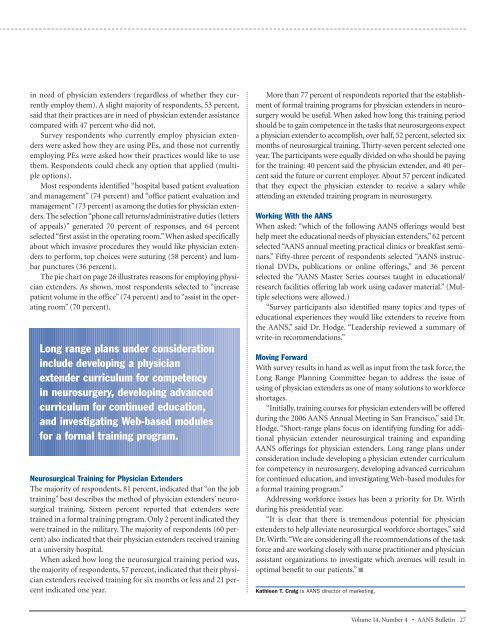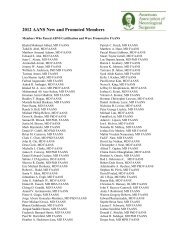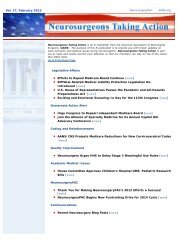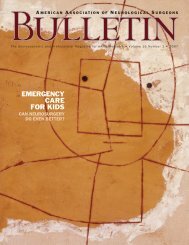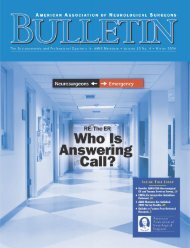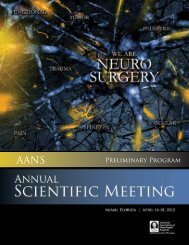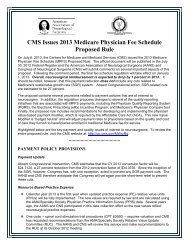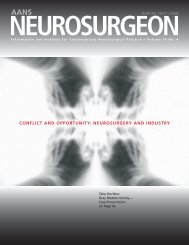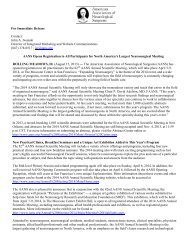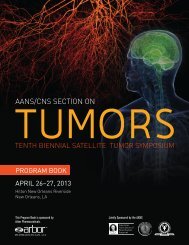view PDF - American Association of Neurological Surgeons
view PDF - American Association of Neurological Surgeons
view PDF - American Association of Neurological Surgeons
Create successful ePaper yourself
Turn your PDF publications into a flip-book with our unique Google optimized e-Paper software.
in need <strong>of</strong> physician extenders (regardless <strong>of</strong> whether they currently<br />
employ them). A slight majority <strong>of</strong> respondents, 53 percent,<br />
said that their practices are in need <strong>of</strong> physician extender assistance<br />
compared with 47 percent who did not.<br />
Survey respondents who currently employ physician extenders<br />
were asked how they are using PEs, and those not currently<br />
employing PEs were asked how their practices would like to use<br />
them. Respondents could check any option that applied (multiple<br />
options).<br />
Most respondents identified “hospital based patient evaluation<br />
and management” (74 percent) and “<strong>of</strong>fice patient evaluation and<br />
management” (73 percent) as among the duties for physician extenders.<br />
The selection “phone call returns/administrative duties (letters<br />
<strong>of</strong> appeals)” generated 70 percent <strong>of</strong> responses, and 64 percent<br />
selected “first assist in the operating room.”When asked specifically<br />
about which invasive procedures they would like physician extenders<br />
to perform, top choices were suturing (58 percent) and lumbar<br />
punctures (36 percent).<br />
The pie chart on page 26 illustrates reasons for employing physician<br />
extenders. As shown, most respondents selected to “increase<br />
patient volume in the <strong>of</strong>fice” (74 percent) and to “assist in the operating<br />
room” (70 percent).<br />
Long range plans under consideration<br />
include developing a physician<br />
extender curriculum for competency<br />
in neurosurgery, developing advanced<br />
curriculum for continued education,<br />
and investigating Web-based modules<br />
for a formal training program.<br />
Neurosurgical Training for Physician Extenders<br />
The majority <strong>of</strong> respondents, 81 percent, indicated that “on the job<br />
training” best describes the method <strong>of</strong> physician extenders’ neurosurgical<br />
training. Sixteen percent reported that extenders were<br />
trained in a formal training program. Only 2 percent indicated they<br />
were trained in the military. The majority <strong>of</strong> respondents (60 percent)<br />
also indicated that their physician extenders received training<br />
at a university hospital.<br />
When asked how long the neurosurgical training period was,<br />
the majority <strong>of</strong> respondents, 57 percent, indicated that their physician<br />
extenders received training for six months or less and 21 percent<br />
indicated one year.<br />
More than 77 percent <strong>of</strong> respondents reported that the establishment<br />
<strong>of</strong> formal training programs for physician extenders in neurosurgery<br />
would be useful. When asked how long this training period<br />
should be to gain competence in the tasks that neurosurgeons expect<br />
a physician extender to accomplish, over half, 52 percent, selected six<br />
months <strong>of</strong> neurosurgical training. Thirty-seven percent selected one<br />
year. The participants were equally divided on who should be paying<br />
for the training: 40 percent said the physician extender, and 40 percent<br />
said the future or current employer. About 57 percent indicated<br />
that they expect the physician extender to receive a salary while<br />
attending an extended training program in neurosurgery.<br />
Working With the AANS<br />
When asked: “which <strong>of</strong> the following AANS <strong>of</strong>ferings would best<br />
help meet the educational needs <strong>of</strong> physician extenders,” 62 percent<br />
selected “AANS annual meeting practical clinics or breakfast seminars.”<br />
Fifty-three percent <strong>of</strong> respondents selected “AANS instructional<br />
DVDs, publications or online <strong>of</strong>ferings,” and 36 percent<br />
selected the “AANS Master Series courses taught in educational/<br />
research facilities <strong>of</strong>fering lab work using cadaver material.” (Multiple<br />
selections were allowed.)<br />
“Survey participants also identified many topics and types <strong>of</strong><br />
educational experiences they would like extenders to receive from<br />
the AANS,” said Dr. Hodge. “Leadership re<strong>view</strong>ed a summary <strong>of</strong><br />
write-in recommendations.”<br />
Moving Forward<br />
With survey results in hand as well as input from the task force, the<br />
Long Range Planning Committee began to address the issue <strong>of</strong><br />
using <strong>of</strong> physician extenders as one <strong>of</strong> many solutions to workforce<br />
shortages.<br />
“Initially, training courses for physician extenders will be <strong>of</strong>fered<br />
during the 2006 AANS Annual Meeting in San Francisco,” said Dr.<br />
Hodge. “Short-range plans focus on identifying funding for additional<br />
physician extender neurosurgical training and expanding<br />
AANS <strong>of</strong>ferings for physician extenders. Long range plans under<br />
consideration include developing a physician extender curriculum<br />
for competency in neurosurgery, developing advanced curriculum<br />
for continued education, and investigating Web-based modules for<br />
a formal training program.”<br />
Addressing workforce issues has been a priority for Dr. Wirth<br />
during his presidential year.<br />
“It is clear that there is tremendous potential for physician<br />
extenders to help alleviate neurosurgical workforce shortages,” said<br />
Dr. Wirth.“We are considering all the recommendations <strong>of</strong> the task<br />
force and are working closely with nurse practitioner and physician<br />
assistant organizations to investigate which avenues will result in<br />
optimal benefit to our patients.” 3<br />
Kathleen T. Craig is AANS director <strong>of</strong> marketing.<br />
Volume 14, Number 4 • AANS Bulletin 27


